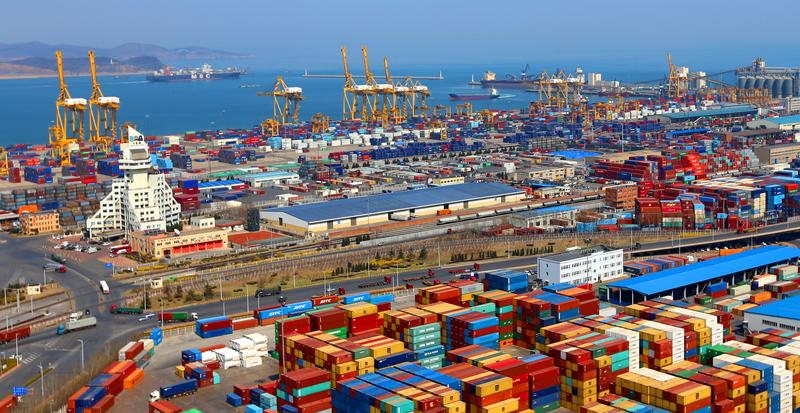 Shipping containers pile up at the Dayaowan container terminal in Dalian Jinpu New Area, Liaoning province. (PIAO FENG / CHINA DAILY)
Shipping containers pile up at the Dayaowan container terminal in Dalian Jinpu New Area, Liaoning province. (PIAO FENG / CHINA DAILY)
Liaoning province is speeding up cooperation with Central and Eastern European countries in the hope of breathing fresh life into its economic revitalization.
"China has great potential and is developing very fast. It has certainly opened up a lot of possibilities for me, both professionally and privately."
Johannes Karlinger, director of the Goethe Institute, Liaoning
Liaoning was elected chairman of the China-CEEC federation of provincial governors in October and given the responsibility of hosting the China-CEEC leaders' meeting next year. The large circle of friendly nations has brought more cooperation opportunities. So far, Liaoning and CEEC have established five pairs of "sister cities", and 11 "friendly cooperative relations".
China and 16 states collectively known as CEEC established a cooperation mechanism in 2012. On April 12, with the inclusion of Greece, it was upgraded to the "17+1" agreement. At present, the two sides have set up more than 20 communication platforms in relation to the economy, culture and education.
Liaoning attaches great importance to cooperation with CEEC and uses this as the basis for full opening-up to the outside world and participating in the construction of the Belt and Road Initiative, the provincial government said.
ALSO READ: Liaoning looks to help two-child families
Liaoning has a population of 43.69 million and covers 148,000 square kilometers, which is equal to the combined size of Austria and Croatia. Rich in natural resources, and with abundant manufacturing facilities and industrial workers, the province was once one of the country's leaders in heavy industry.
In the 1970s, it was among the top three industrial centers along with Shanghai and Tianjin. But in the following decades its fortunes declined as it struggled to adapt to the structural reforms of the new market economy, largely because of high operating costs, falling investment and low government efficiency.
In April 2016, the central government rolled out new measures to revitalize the provincial economy. Reforms included the establishment of a free trade zone, the streamlining of administration and improvement of the business environment.
New friends
The push for closer cooperation with CEEC members in recent years has been led by Tang Yijun, governor of Liaoning.
Tang called for the coastal province to be turned into a demonstration zone between China and CEEC through investment, transportation links and cultural exchanges.
"CEEC has a lot of goods we need, such as high-quality machinery, agricultural products and food," Tang said in an earlier interview.
"We have many advantages in infrastructure construction, manufacturing and modern agriculture. The cooperation is win-win."
According to data from the Liaoning Commerce Department, imports and exports between Liaoning and CEEC last year reached 15.7 billion yuan (US$3.32 billion), an increase of 32 percent year-on-year.
Liaoning entrepreneurs have established international industrial parks in Romania, Serbia and the Czech Republic.
Zhou Liandong, manager of Yingkou Yuyuan Industrial said the company's Romanian industrial park has been approved as a Liaoning provincial overseas economic and trade cooperation zone. His company manufactures textiles and garments, chemical fibers and plastics, building materials and electric vehicles.
Golden opportunity
Li Kai, deputy director of the Northeast Revitalization Research Institute at Northeastern University, pointed out that it is the golden time for Liaoning to set up a China-CEEC center to promote regional stability and economic prosperity.
In addition to economic and trade cooperation, Liaoning has built a number of international transport corridors. Shenyang is the main international rail transportation base. Dalian and Yingkou are two major ports linking to CEEC members.
Liaoning's China-Europe Railway Express connects the province to three capitals: Warsaw in Poland, Prague in the Czech Republic and Bratislava in Slovakia. Last year, Yingkou Port transported 720,000 containers to Europe via the China-Europe Railway Express.
Dan Tarcea, deputy mayor of Cluj-Napoca in Romania suggested Liaoning and CEEC could also enhance cultural and educational cooperation to improve mutual understanding.
Universities in Liaoning have already cooperated with Germany and Poland on education. CEEC universities have also launched Confucius Institutes, whose stated aim is to promote Chinese language and culture, with the help of their Liaoning counterparts.
READ MORE: CNS Liaoning leads exercise in west Pacific
"China has great potential and is developing very fast. It has certainly opened up a lot of possibilities for me, both professionally and privately," said Johannes Karlinger, director of the Goethe Institute in Liaoning.
"Moving to China has worked out very well for me and I've even invited my family to come and visit me in China. They are all very excited to come."
Contact the writers at wuyong@chinadaily.com.cn



